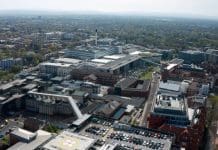Dean Douglas of BIM Academy examines the development of digital twins and how they could evolve to create a cleaner, greener built environment
With buildings accounting for more than a third of total energy consumption, we all have a role to play in addressing the impact this is having on our environment. Alongside net zero commitments and ambitious target setting by the UK government, increased net zero legislation has now arrived. But is it enough?
If we are to begin to meet these ambitious targets then we need a robust digital process for measuring, monitoring and managing building performance and usage data that will enable us to better analyse, compare and optimise the performance of our buildings is essential now more than ever. Could digital twins present the answer?
Why digital twins?
In recent months, we have witnessed the growth of the digital twin – it is hailed as one of the most prominent innovations of the built environment in current times, but simultaneously it is one of the most hotly debated. As industry and academia alike investigate how the digital twin can be defined, implemented and what its benefits could be in a variety of scenarios.
At its most basic level, the digital twin comprises of three core elements:
- A physical asset.
- A digital replica of that asset.
- The bi-directional flow of data between the digital and physical.
The physical asset can be almost anything, whether that be a plane, a building or a railway network, already widening its potential application for usage.
The second constituent element, however, is slightly more complex and poses one of the greatest challenges in the creation of digital twin as it requires the identification, collection, collation and curation of numerous datasets that have the potential to provide insights into an asset’s operation and maintenance.
Equally, the datasets that can be incorporated seem limitless. With data sources such as BIM, GIS, asset management systems, legacy asset information, as well as sensor data, all having the potential to enrich a digital twin and provide insights into its twinned physical asset.
In addition to datasets directly pertaining to an asset, there is also the ability to incorporate a plethora of contextual datasets, eg meteorological data, user experience and topographic data to provide greater depth to asset information.
It is through the combining of these previously independent or disjointed datasets that could unlock deeper insights into the condition, efficiency and usage of our built assets. Through establishing new and enhancing existing understanding of interdependencies within a building, which can then be leveraged to better inform and optimise its operation and maintenance, such as assessing and monitoring its carbon impact.
Following on from that, the bidirectional link between the two the physical and digital world crucial in setting a digital twin apart from the likes of a BIM or GIS model. The creation of a cyclical loop of “physical world-digital world-physical world” is what enables the digital twin to not only create a repository of up-to-date asset data but also having the ability to leverage that data to generate insights that allow for informed decision making, leading to optimisation and potential automation of operational usage.
The abilities of digital twin
As previously stated, and it’s worth repeating, the vehemently debated possibilities for digital twins seem near-endless, but in order to realise where its application will be most beneficial, the abilities of digital twin that must first be understood. It is then that we can begin to meaningfully integrate digital twin into our NZC efforts.
Boje, C et al’s 2020 paper, Towards a Semantic Construction Digital Twin: Directions for Future Research, suggests that there are considered to be four primary abilities of digital twin: simulation, control, monitoring and prediction, all of which could be instrumental in the ambition to achieve net zero carbon throughout an asset’s operational life.
However, the abilities of the digital twin also seek to utilise a multitude of digital technologies such as AI, big data, machine learning and IoT among others to generate their insights. That can then enable better decision making based on better analysed data throughout an asset’s lifecycle. These could help bring about resource efficiency, energy resilience, targeted upgrades repairs and replacements, and even the decarbonisation of ecosystems of assets such as estates or cities.
The digital twin of the future
Looking forward, the ability to interconnect digital twins that are able to communicate and share data between one another will be invaluable.
With the Centre for Digital Build Britain’s (CDBB) National Digital Twin programme striving to develop a common computational framework that can be ingrained in the development of all digital twins, will enable their interlinking.
This does not, however, strive to create a single model of the entire nation, but instead looks to creating an ecosystem of digital twins where numerous interdependent digital twins of different asset types can share data. For example, where a digital twin of a train shares and receives data from the digital twins of the tracks, the wider rail network, the power grid and so on, to together build a holistic view of the rail system – a feat that previously we had neither the opportunity nor the technical ability to do.
And it is through this newfound ability to be able to analyse and predict, demand and usage on a mass scale, that we can begin to better understand how to sustainably manage and make provisions for future assets.
The built environment not only has a responsibility to deliver high quality, fit for purpose assets, but also assets that address wider social and environmental concerns. The continued expansion of the abilities presented by digital twins could very well be leading us into a cleaner, greener building process.
Dean Douglas
Researcher
Tel: +44 (0) 191 269 5444
Twitter: @bimacademy
LinkedIn: BIM Academy
YouTube: wwwbimacademyacuk
Instagram: @bim.academy














